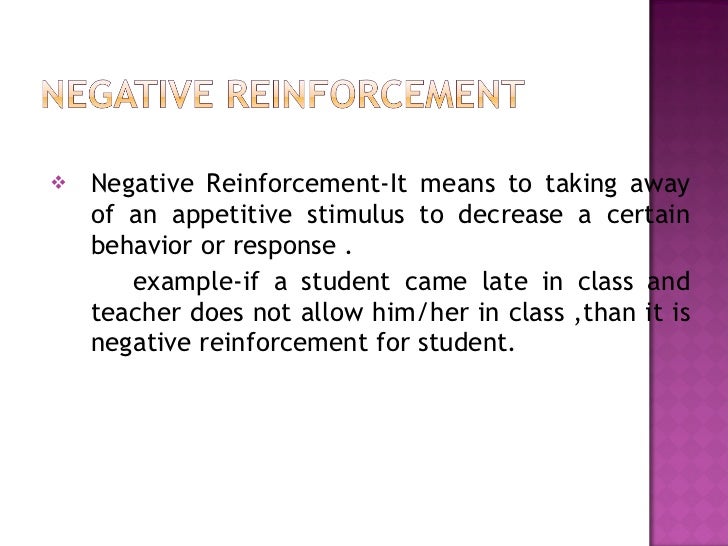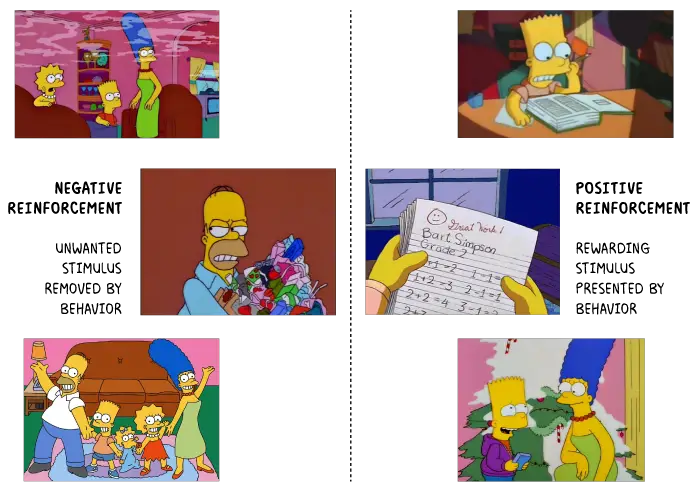Negative reinforcement is the encouragement of certain behaviors by removing or avoiding a negative outcome or stimuli. People typically use this technique to help children learn good patterns of. Examples of Negative Reinforcement Quick Reminder of What Negative Reinforcement Is. Negative reinforcement occurs when something already present is removed (taken away) as a result of a behaviour and the behaviour that led to this removal will increase in the future because it created a favourable outcome.
Classroom management can be a very challenging part of teaching. Keeping 20-30 students calm, engaged, and motivated to learn is no easy feat! For optimal learning, it is necessary for the teacher to have the student’s behavior under control. It is also important for students to be given clear expectations so they know exactly what behaviors are expected in the classroom. Just as the principles of reinforcement and punishment can be utilized in the home, they can also be used to help with the management of behaviors at school.
Using Reinforcement in the Classroom:
Reinforcement is a consequence following a behavior that increases the probability that the behavior will increase in the future.
In addition to keeping behavior under control, reinforcement in the classroom should be used to keep students engaged and motivated to learn. Teachers should use reinforcement often in order to maintain a positive learning environment and to promote appropriate classroom behaviors.
Examples of reinforcers that can be used in the classroom include the following:

- Teacher praise
- Earning privileges
- Teacher attention
- Taking away a homework assignment
- Extra recess time
- Extending a deadline
Using Punishment in the Classroom:

Punishment is a consequence following a behavior that decreases the probability that a particular behavior will occur in the future.
Punishment should be used in the classroom to decrease undesirable behaviors. Punishment in the classroom needs to be implemented with care, and should never be used to single students out or to punish behaviors that are due to a specific disability. If a particular student has challenging behaviors as a result of a disability, it is important to seek additional assistance so a behavior plan tailored to that child can be developed.
Generally, reinforcement should be the primary strategy utilized in the classroom, but if punishment is necessary, it should be the least restrictive type of punishment. Before implementing any punishment strategies, it is important to check with your school’s policy on appropriate classroom management strategies and what is and is not permitted in your specific school.
Examples of punishments that have been used in classroom include the following:
- Loss of recess time
- Extra homework
- Loss of other privileges
- Detention
Examples of more restrictive and inappropriate punishments include sending a student to a solitary time-out room and missing lunch or snack.
Many teachers use classroom-wide behavior management systems that utilize both reinforcement and punishment. These systems are very popular in many classrooms because they can be easy to implement and the students know exactly what is expected of them.

Classroom-wide behavior management systems that utilize both reinforcement and punishment:
- Stoplight Management System: A large stoplight with green, yellow, and red is placed in the classroom along with moveable buttons or clothespins with each student’s name. The students begin each day on green, but depending on their behavior can move to yellow or red. At the end of the day the students who are still on green receive some type of reward or privilege.
- Token Economy: A behavior change system where students earn tokens for engaging in specific behaviors and then at a specified time, can exchange those tokens for desired items.
- Group Contingencies: These types of contingencies occur when one consequence is delivered based on the behavior or performance of either certain students or all of the students in the classroom. There are three different types of group contingencies.
- Independent group contingency: A reward is available to all of the students in the classroom, but only students who meet the specific criteria earn the reward.
- Dependent group contingency: The reward for the entire group is dependent on the behaviors or performance of one specific student or small group.
- Interdependent group contingency: All of the students in the classroom are required to meet the specific criteria (both individually and as a group) before earning a reward.
Disadvantages Of Negative Reinforcement In The Classroom
Read our other blogs on reinforcement and punishment:
Extinction refers to a procedure used in Applied Behavioral Analysis (ABA) in which reinforcement that is provided for problem behavior (often unintentionally) is discontinued in order to decrease or eliminate occurrences of these types of negative (or problem) behaviors.
While this procedure is most commonly used in children with Autism and Down Syndrome, it can also be used very successfully to address a broader array of problem behaviors, including those exhibited by individuals without developmental disabilities.
Extinction procedures often take three different forms depending upon the functions of the behavior (i.e. What is causing the behavior). One of the forms is to use extinction with behaviors maintained by positive reinforcement.
Example: Dannie tries to get mom's attention by dropping her toy on the floor. Her mom smiles at Dannie, picks up the toy and hands it back to her. This series of actions reinforces Dannie's negative behavior because she is getting the attention that she is seeking. As a result, she will continue to engage in this type of behavior in order to receive the positive reinforcement that her mom provides. To address this problem, Dannie’s mom should ignore Dannie when she drops the toy; if she consistently ignores this problem behavior, it is highly likely that Dannie will reduce engaging in this behavior as her actions no longer produce the effect that she is seeking.
Another form of this procedure is extinction on behaviors maintained by negative reinforcement. This is commonly referred to as “escape extinction.”
Example: Dannie throws a tantrum when she doesn’t want to eat her food. Her mom responds by sending her to a ‘corner’ for time out. Because Dannie is able to avoid eating the food that she doesn’t want to eat, it is highly likely that she will engage in the same behavior in the future. To correct this, Dannie’s mom should let Dannie throw tantrums (regardless of how long it takes), while continuing to insist that Dannie eat her food. Initially, these tantrums will increase as Dannie becomes more and more frustrated, but eventually her tantrums will decrease as long as her actions do not provide her with the desired outcome.
The third form of this procedure is extinction on behaviors maintained by automatic reinforcement. This is commonly referred to as “sensory extinction.”
Negative Reinforcement In The Classroom Pdf
Example: Dannie likes to turn the light switch on and off because she is visually stimulated by the fan starting and stopping. In order to address this behavior, Dannie’s mom should disable the fan so that when Dannie flips on the light switch, she no longer gets the visual stimulation from the fan starting and stopping. Over time, Dannie will decrease engaging in this behavior of flipping the light switch because it no longer provides the automatic reinforcement she is seeking.
More facts about extinction procedure:
•An increase in the negative behavior will likely be observed shortly after extinction procedures are implemented: this is referred to as an extinction burst. It is very important for the person administrating therapy to maintain consistency and continue with the procedure, regarding of the child’s reaction.
Typically, extinction bursts will increase initially and the child will engage in this negative behavior more frequently before the behavior goes away or decreases to an appropriate level. Extinction bursts can also happen after a long period during which the child does not engage in problem behavior. This is referred to as Spontaneous Recovery. It is very important to be mindful of this possibility in order to be prepared to deal with it in the same way the behavior was dealt with initially.
•All three forms of extinction procedures decrease the occurrence of problem behavior over time.
•Very simply, extinction equates to lack of reinforcement. Instead of getting something good to strengthen the behavior, or having something added or taken away to suppress the behavior, nothing happens. From the perspective of the child, the behavior no longer works to get the desired reinforcement any more.
Example Of Negative Reinforcement In The Classroom
•All forms of extinction procedures can be frustrating for the learner. Their level of frustration varies from learner to learner in each specific situation.
School Examples Of Negative Reinforcement


•Extinction procedures can also be frustrating for parents and caregivers because the reduction in positive behavior (behavior change) can be slow. This is generally tolerable if the behavior is mildly protesting or attention seeking, such as whining or crying. However, if the behavior involves self-injury or direct aggression to siblings, parents or caregivers, and it intensifies during the “extinction burst” period, parents may find the procedure to be impossible to maintain.
In these situations, implementing an additional procedure to increase the desired behavior, e.g., giving a reward of allowing a child to take smaller bites (for a selective eater), rewarding a child when he plays with his sibling to reduce aggression toward them, or increasing privileges for carrying out previously agreed-upon chores (a “behavioral contract”) to increase compliance with directions, and other similar techniques can be quite helpful.
Positive And Negative Reinforcement In The Classroom
To learn more about Applied Behavior Analysis (ABA) intervention and common methods used to reduce problem behavior, check out our ABA Online Training Course.
Negative Reinforcement In Classrooms What We're Beginning To Learn
Copyright © by Special Learning Inc. All right reserved.
No part of this article may be reproduced in any manner whatsoever wi thout written permission except in the case of brief quotations embodied in critical articles and reviews. For information, contact Special Learning Inc., at: contact@special-learning.com




